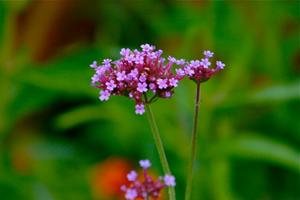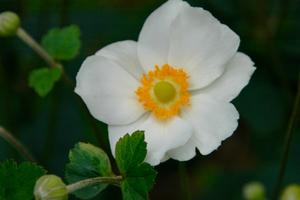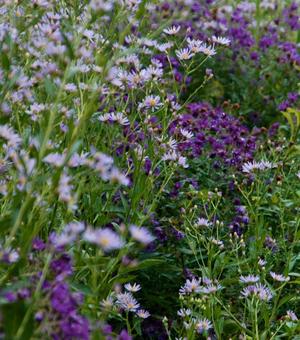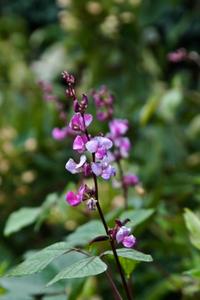In Georgetown gardens, having it both ways

I used to think that fall was about orange, red, and yellow, a lesson learned in nursery school, when, under Mrs. Thomson’s watchful eye, we ironed fall leaves between pieces of waxed paper. There is ample annual evidence to support this belief in the form of pumpkins, fall foliage, and candy corn, but when I began to garden, I learned different. Fall is really about purple.

This was an important revelation because I have a hard time with summer’s end. I begin to mourn after the summer solstice, so, I was thinking: You could plant a garden that presents the illusion that summer hasn’t ended, even though leaves start turning and pumpkins start appearing elsewhere, simply by using the color purple – and a bit of blue, lavender, and white.
To “do” a purple fall garden, I would start with good evergreen bones, including trees that either turn color late in the season or not at all – hornbeams, beeches, conifers, and evergreen magnolias with a touch of boxwood and rhododendron would do the trick. A dash of chartreuse would be a perfect accent for purple, so we would include Annabelle hydrangeas, which by September have gone from white to celadon. We will assume that we have full sun, dappled sun, and shade with nice moist soil – an ideal garden.

We will edge our flowerbeds with variegated Monkey Grass (Liriope muscari “Variegata”), which thrives in these different exposures. It will please us with its low spikes of tiny intense purple flowers starting in August, blooming well into October. This bourgeois plant may not seem an inspired selection, but liriope is a workhorse that reliably looks smart in all seasons and tolerates a lot of abuse. You can always tuck oodles of small bulbs through it for early spring interest. Just cut it back in late winter, before the new grass and bulb shoots appear, and the bulbs will take over. By the time they are done, the new grass shoots should be up.
Behind the liriope, in the shade, we will plant two kind of toad lily (trycirtus). They are so striking, we don’t want to have to pick one or the other, believe me. The Japanese native, Trycirtus hirta, has long arching stems along which multiple pairs of narrow pointed leaves grow. This provides excellent architectural form all summer, but to make matters even better, by late summer, buds appear just where the leaves meet the stem, in the leaf axils. By September, the swelling buds become small, exquisite orchid-like flowers, pure white or, for our garden, a mottled white, deep plum, and amethyst. Its’ Taiwanese cousin, Trycirtus formosana, has similarly charming flowers, but they are born in loose clusters on top of upright stems, reminiscent of tiger lily stems, about 24-30 inches tall. I adore these – stop reading and order some right now!

Nearby, where there’s more sun, we will plant Japanese anemones that will form handsome, substantial clumps. While there are attractive pink forms, our garden should have 2-3 foot white ones, Anemone x hybrida “Honorine Jobert”. An anemone perfected in France, she has adorned fall gardens since the late 1850’s and with good reason because she is an elegant, lofty perennial that blooms into October. Japanese anemones have jaggedy leaves, typical to anemones of all sorts, and their flowers are born on delicate stems above the bulk of their foliage, so they appear to float magically above other plants. The reason we are putting in white ones is because they will relate well to the green and white leaves of our variegated liriope and our lovely purple and white trycertis blossoms.
To add a little punch to our color theme, we should add some perennial ageratum, or Eupatorium coelestinum, a 2-3 foot tall American native that likes sun and can take some shade. The electric-blue-lavender clusters of small fuzzy flowers appear in July and continue on through October. A favorite of various butterflies, including monarchs, it would look especially wonderful in our purple garden if it was planted near a maroon leafed plant like a purple smoke bush, or with purple Michaelmas daisies (aster).

And speaking of asters, there are so many species; it’s hard to choose. They would dominate the sunniest part of our garden near the Annabelles, where we would pinch them once or twice in the summer so they don’t grow too tall. Some grow 4-5 feet in height, and they range in color from pink to light lavender, to deep, regal purple. One of my favorites is the native, aster novae-angliae “Purple Dome”, which tends to the darker side. It would make our ageratum look neon. We could slip in a lavender aster for even more contrast.
To give the sunny part of our garden a bit of inter-temporal continuity, we should add the annual Purple-top Vervain (Verbena bonariensis), which will begin blooming in early summer, not stopping until frost. Growing 3-4 feet tall, it’s best planted in groups where butterflies can hover dramatically over their clusters of tiny violet flowers. This drought tolerant vervain self-sows, but I impatiently plant seedlings to hasten the blooming process.

Finally, because we like variety, whimsy, and surprise, and we love history, we should plant hyacinth beans (Dolichos lablab), like Thomas Jefferson did at Monticello. I plant the seeds in a sunny spot in spring, after the soil warms. Their leaves are bluish green with purple veins, on smooth purple stems that cling like morning glories to their support. Their pea-like flowers, lavender and fuchsia, grow on 6-8 inch purple spikes. As if this is not glorious enough, the beans are dark, glossy magenta. I have never eaten them, but have heard you should change the water in which they are boiled twice.
We could sit in our purple fall garden for several weeks, pretending it’s still summer, while the world around us goes classically autumn. Of course, we would then have the best of both worlds: Extended summer in our own garden, and the pleasure of walking past pumpkins through yellow and orange leaf strewn streets in the real world. Who says you can’t have it both ways?





